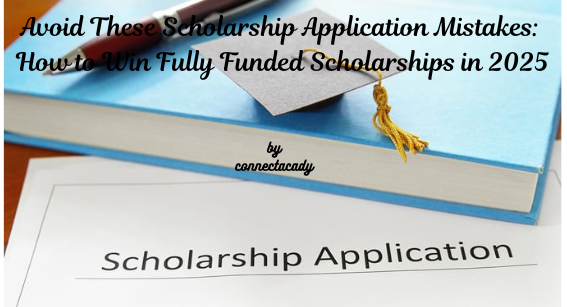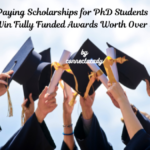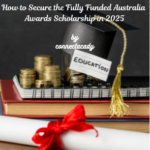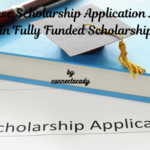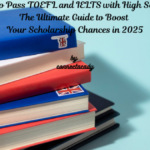Are you dreaming of landing one of the many fully funded scholarships in 2025 but don’t know why your past applications never made the cut? Well, you’re not alone. Thousands of students worldwide apply each year with high hopes, only to get rejection emails that sting. But here’s the truth: it’s usually not because you’re not smart enough, it’s because of avoidable mistakes.
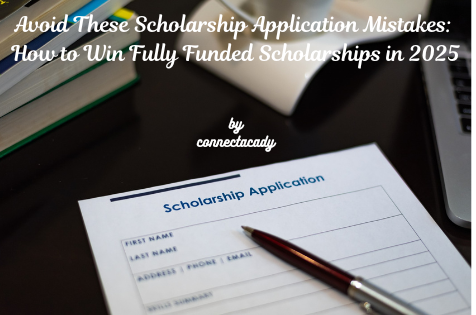
This blog post will walk you through the biggest errors students make when applying for scholarships and give you powerful, actionable strategies to position yourself as a top contender. Whether you’re applying for undergraduate, master’s, or PhD opportunities, by the end of this article, you’ll be fully equipped to avoid pitfalls and increase your chances of winning that dream scholarship.
Understanding the Value of Fully Funded Scholarships
What Are Fully Funded Scholarships in 2025?
Fully Funded Scholarships in 2025 are a golden opportunity for students seeking higher education without the financial stress. These scholarships cover tuition fees, accommodation, books, travel costs, and sometimes even monthly stipends. Imagine graduating without student loan debt, it’s not just a dream; it’s possible.
These programs are typically offered by governments, top universities, and global foundations aiming to support brilliant minds from underserved regions. Scholarships like Chevening (UK), DAAD (Germany), and the MasterCard Foundation are some of the most sought-after.
Explore platforms like Scholarships.com, DAAD.de, and Chevening.org to begin your journey.
Real-Life Impact of Getting Your Education Funded
The impact of securing Fully Funded Scholarships in 2025 goes far beyond saving money. For many students, it means access to world-class education, global exposure, and life-changing career opportunities.
Take for example, Sarah, a rural Nigerian student who won a Fulbright scholarship to the U.S. Today, she’s a data analyst at Google and also mentors students back home.
Here’s what these scholarships give you:
- Debt-free education from top-ranked universities
- Global networks and cultural immersion
- Enhanced career prospects in international organizations
It’s not just about education, it’s about unlocking a global future.
The Most Common Scholarship Application Mistakes
Even the brightest students often lose out on fully funded scholarships in 2025 due to simple, avoidable mistakes. Here’s how to sidestep the most common pitfalls and boost your chances of securing your dream award.

Missing Deadlines
Time waits for no one and neither do scholarship committees. Missing the deadline means instant disqualification. Use digital tools like ScholarshipOwl or Google Calendar to set early reminders. Apply at least one week in advance to avoid tech glitches.
Incomplete Applications
A missing document like your transcript or ID can cost you everything. Always double-check the checklist. A helpful tip? Create a “scholarship folder” for each opportunity with all required docs.
Weak Personal Statements
Scholarship essays make or break your application. Avoid vague phrases like “I want to make a difference.” Instead, share a personal story with clear goals. Need help?
Ignoring Eligibility Requirements
Don’t waste time on scholarships you’re not qualified for. Check for academic level, nationality, age limits, and field of study. If it says “only for master’s programs,” don’t apply with a PhD plan.
Submitting Generic Essays
Copy-pasting the same essay won’t cut it. Tailor each essay to the scholarship’s mission. Mention how your goals align with their values. This tactic improves engagement and boosts your selection odds.
Lack of Recommendation Letters
Reach out early to mentors who truly know you. Offer a draft to guide their letter and make their job easier.
Overlooking Scholarship Instructions
PDF required? Don’t send Word. Asked for three references? Send three, not two. Read every detail.
For anyone chasing fully funded scholarships in 2025, avoiding these errors is step one to winning life-changing opportunities.
How to Write a Winning Scholarship Essay
Writing a powerful essay is one of the most important steps in securing fully funded scholarships in 2025. It’s your chance to stand out in a sea of applicants. So how do you craft a piece that’s memorable, authentic, and compelling? Let’s break it down step-by-step.
Structuring Your Essay
Your essay should be more than just a collection of thoughts, it needs a clear structure that flows naturally. A winning format includes:
- An engaging introduction: Hook your reader with a bold statement or personal story.
- A solid body: Highlight your achievements, challenges, goals, and community impact.
- A powerful conclusion: End with how the fully funded scholarship in 2025 will help you make a meaningful difference.
Think of it like a movie. If the beginning is boring, no one sticks around for the ending.
Avoiding Cliché Content
If you write “I want to study abroad to make the world a better place,” stop right there. Everyone says that.
Instead:
- Be specific about your goals.
- Share a unique experience that shaped your passion.
- Show, don’t just tell.
For example: “After witnessing my village struggle with access to clean water, I developed a passion for environmental engineering.”
Using real-life stories is one of the most effective strategies to increase your essay’s impact and conversion rate.
Crafting a Powerful Narrative for Fully Funded Scholarships in 2025
Scholarship panels aren’t just looking for grades, they want future changemakers. Use your essay to connect the dots between your past experiences, current goals, and how fully funded scholarships will empower you to serve your community and field.
Crafting a Strong Scholarship Resume
Creating a powerful resume is one of the most overlooked yet critical components of winning fully funded scholarships in 2025. Think of your resume as your personal billboard. It’s your one-page pitch to scholarship panels. If it’s sloppy, generic, or irrelevant, it could send your application straight to the rejection pile, no matter how brilliant you are.

What to Include and What to Skip
To create a standout resume, focus on relevance, clarity, and impact. Here’s what to include:
- Academic Achievements: GPA, honors, awards
- Leadership Roles: school captain, club president, volunteer coordinator
- Volunteer Experience: community outreach, NGOs, religious or youth groups
- Certifications: online courses related to your field (e.g., Coursera, edX)
- Key Skills: languages, research, public speaking, digital tools like Excel or Canva
What to skip:
- Unrelated work experience (unless it teaches transferable skills)
- Long paragraphs, use bullet points instead
- Hobbies that don’t enhance your academic or leadership profile
Use a clean, modern design with clear headers and consistent formatting. Tools like Canva or Novoresume make it easy, even if you’re not a designer.
Tailoring It to Different Scholarships
Not all scholarships are created equal. Some focus on leadership and innovation, while others prioritize academic excellence or community service. So, you can’t afford to send the same resume everywhere.
For example:
- Applying for the Chevening Scholarship? Highlight international leadership experience.
- Targeting a STEM scholarship in the USA? Emphasize research projects and coding skills.
- Aiming for Commonwealth scholarships? Showcase your commitment to local development.
The key? Mirror the language of the scholarship provider in your resume and align it with the values they promote.
Make no mistake, your resume can make or break your chances of securing fully funded scholarships in 2025. Take the time to tailor it, polish it, and make it resonate with the opportunity at hand.
Getting Impressive Letters of Recommendation
Who to Ask
When applying for fully funded scholarships in 2025, one of the most overlooked elements is your letter of recommendation. Yet, this document often acts as the final push your application needs to stand out from the pile.
But here’s the catch: not all recommenders are created equal.
Choose people who:
- Know you personally and professionally
- Have witnessed your academic or leadership growth
- Can speak about your work ethic, resilience, and integrity
Ideal recommenders include:
- Professors from your major field of study
- Project or thesis supervisors
- Internship or volunteer coordinators
- Employers from relevant part-time jobs
Avoid asking relatives or people who barely know your work, they won’t carry weight with scholarship panels.
Please note, If the scholarship targets leadership or community impact, prioritize someone who’s seen your non-academic achievements, like organizing events or leading campaigns.
Check this to know expert strategies to secure strong scholarship letter of recommendation.
How to Make It Easier for Them
Remember, your recommender is doing you a favor. Make the process as smooth as possible so they can focus on writing you a glowing letter, not scrambling for details.
Here’s how to help:
- Provide a brief resume or academic CV
- Share a summary of your goals and the scholarship you’re applying for
- Include the deadline and submission method (upload/email/portal)
- Give them at least 3–4 weeks’ notice
- If required, offer a template or sample letter to guide their writing.
By preparing your recommender properly, you increase your odds of receiving a personalized, powerful letter that aligns perfectly with the values of the scholarship selection committee.
Organizing Your Scholarship Search
Scholarship Tracking Tools
Let’s face it, juggling 10+ scholarship applications across different deadlines, documents, and platforms is enough to make anyone’s head spin.
That’s why organizing your search is critical if you’re serious about winning fully funded scholarships in 2025.
Here are top tools to keep you organized and efficient:
- ScholarshipOwl: Automatically matches you with scholarship opportunities and helps manage deadlines
- Trello or Notion: Create boards or pages to track progress, uploads, and documents
- Google Sheets: Simple spreadsheet format to record status, links, eligibility, and deadlines
High-Paying Scholarship Platforms
To increase your odds of getting scholarships, focus on high-paying, reputable scholarship databases. These include:
- Chevening Scholarships (UK)
- DAAD Scholarships (Germany)
- Fulbright Scholarships (USA)
- MasterCard Foundation Scholars Program (Africa-focused)
- Erasmus Mundus Joint Master Degrees (Europe)

These scholarships don’t just offer full tuition, they often include living stipends, travel costs, and career support.
If you’re serious about winning big this year, you need more than just ambition, you need strategy and structure. Use the right tools, connect with the right people, and stay ahead of deadlines, and you’ll be miles ahead of the competition.
Tools and Resources That Can Help You Win Scholarships
In today’s competitive academic environment, having the right tools at your fingertips can be the difference between getting shortlisted or getting overlooked. If you’re aiming to win fully funded scholarships in 2025, leveraging smart digital tools is no longer optional; it’s essential. From AI-powered writing assistants to professional essay editing services, here’s what you need to supercharge your scholarship application.
Scholarship Essay Editors
Your scholarship essay is where your story truly comes alive. It’s the one chance you have to speak directly to the scholarship committee, so make it count.
Why you need an editor:
- Even if you’re a great writer, you might miss grammatical errors or lack clarity in certain areas.
- Editors help shape your narrative, improve readability, and ensure your tone matches the scholarship’s values.
Top platforms to consider:
- Scribbr: Offers detailed proofreading and structure checks specifically for academic essays.
- Grammarly Premium: Great for grammar and tone enhancements in real-time.
- ScholarshipOwl Essay Editor: Tailored for scholarship submissions, with expert insight on what reviewers look for.
AI Tools to Refine Your Applications
Think AI is just a buzzword? Think again. AI is transforming how students apply for scholarships by making the process faster, smarter, and more personalized.
Here are the top AI tools to help you win fully funded scholarships in 2025:
- Jasper AI: Great for brainstorming essay drafts and unique content angles.
- ChatGPT: Helps outline and polish personal statements based on your life story.
- Quillbot: Excellent for paraphrasing and rewording repetitive sentences.
- Canva: Design stunning scholarship resumes and visual components with ease.
These tools aren’t here to replace your creativity but they enhance it. For example, you can use ChatGPT to draft a response and then edit it using Grammarly and Quillbot for fluency and professionalism.
Country-Specific Application Strategies
Applying for scholarships internationally? Tailoring your strategy based on your target country can significantly boost your success rate. Let’s break it down:
Scholarships in the USA, UK, Canada, and Europe
Each region has unique expectations and criteria.
- USA: Emphasis on academic excellence, leadership, and extracurriculars. Check out the Fulbright Program for global applicants.
- UK: Programs like Chevening Scholarships value future impact and leadership.
- Canada: Balanced approach—grades, volunteerism, and research potential all matter. Explore the Vanier Canada Graduate Scholarships.
- Europe: Programs like Erasmus Mundus are known for fully funded multi-country degrees.
Quick Tips:
- Understand local education systems (e.g., GPA vs. percentage systems).
- Use native formats for resumes and recommendation letters.
- Highlight global impact goals in your essay for Western programs.
Fully Funded Opportunities for African and Asian Students
If you’re from Africa or Asia, don’t feel discouraged, there are hundreds of targeted opportunities available to you.
Top picks for fully funded scholarships in 2025 include:
- MasterCard Foundation Scholarships – Available at partner universities in Africa, USA, and Canada.
- Commonwealth Shared Scholarships – For students from low and middle-income countries in the UK.
- MEXT (Japan) – Offers tuition, travel, and living expenses.
- Chinese Government Scholarship (CSC) – Covers full tuition, accommodation, and monthly stipend.
Leveraging Online Courses and Certifications
Building Credibility Before Applying
In the competitive world of fully funded scholarships in 2025, standing out is everything. And one simple way to boost your credibility? Online certifications.
Before scholarship committees even glance at your GPA or essay, they want to know: What have you done to prove your passion? Enrolling in online courses related to your field of study shows initiative, curiosity, and a proactive mindset.
Let’s say you’re applying for a data science scholarship. Completing a free or paid course on Coursera, edX, or Udemy can give you an edge. Add it to your resume, mention it in your personal statement, and you instantly look more serious than 90% of applicants.
Pro Tips:
- Choose reputable platforms like Harvard Online, Khan Academy, or FutureLearn.
- Focus on certifications with strong academic or industry backing.
- Keep your certificates organized in a digital folder. You’ll need them when filling out scholarship forms.
Platforms Offering Scholarship-Linked Programs
Some platforms go beyond just offering courses, they actually collaborate with scholarship providers.
Here are a few top-tier platforms that not only offer valuable certifications but sometimes open doors to scholarships:
- ALX Africa: Offers free tech training and connects graduates with top global opportunities.
- edX: Some partner universities offer scholarship-based master’s programs on this platform.
- LinkedIn Learning: Useful for leadership, communication, and professional development courses often valued in scholarship applications.
- Coursera for Campus: Offers institution-backed scholarships for remote learners globally.
Use these platforms not only to upskill but also to tap into their affiliate university programs, which often lead to admission + scholarship bundles. This is an opportunity many overlook.
How to Deal with Rejection and Improve Your Next Application

Common Feedback from Scholarship Panels
Getting that dreaded rejection email? Don’t take it personally, learn from it.
Most committees won’t give you detailed feedback, but the usual suspects include:
- Generic essays lacking personal connection
- Incomplete applications or missing documents
- Failure to meet eligibility requirements
- Lack of evidence of passion for the field
A key insight from past scholarship recipients is this: the more personalized and focused your application, the higher your chances.
Instead of asking, “Why didn’t I get it?” start asking, “How can I improve next time?”
Creating a Personal Scholarship Action Plan
So, what do you do next?
- Review your past applications: Did you follow instructions? Customize your content?
- Set clear monthly scholarship goals: Apply for 3–5 per month.
- Join online scholarship communities: Forums like Scholarship Positions, The Scholarship Hub, and Facebook groups give real-time tips.
- Work with a mentor or coach: Many past winners offer coaching for affordable rates.
- Update your documents: Revise your personal statement, polish your resume, and gather better references.
Use tools like Trello or Notion to organize your applications, set reminders, and track outcomes. It’s not about luck, it’s about consistency and strategy.
Do note that success in securing fully funded scholarships in 2025 comes from learning, adapting, and trying again smarter.
Conclusion
The journey to securing fully funded scholarships in 2025 doesn’t have to be overwhelming but it does require intentionality. From missing deadlines to submitting generic essays, the most common scholarship mistakes are surprisingly easy to avoid when you’re well-prepared.
To recap, here are the top mistakes:
- Missing deadlines and ignoring instructions
- Submitting incomplete applications or weak recommendation letters
- Writing vague or one-size-fits-all personal statements
And here’s how to win:
- Start early and stay organized with a scholarship tracker
- Tailor every application to the specific scholarship provider’s goals
- Use high-quality tools like Grammarly for editing and ScholarshipOwl for matching
By applying smart, customizing your materials, and focusing on clarity and impact, you can significantly increase your chances of landing fully funded scholarships in 2025, whether it’s through DAAD, Chevening, Erasmus, or local university grants.
Remember, scholarships aren’t just about grades—they’re about your story, vision, and preparation.
Share this post with a friend who’s applying for scholarships too—you could be the reason they win big!
Frequently Asked Questions
1. What’s the most common mistake in scholarship applications?
The biggest mistake is not tailoring your application. Scholarship committees want to feel like you’re applying to their opportunity, not just any scholarship.
2. How can I increase my chances of winning scholarships in 2025?
Use a scholarship calendar, focus on quality essays, and apply to at least 10–20 opportunities relevant to your field.
3. Do all fully funded scholarships in 2025 require high GPAs?
Not necessarily. Many consider leadership, volunteer experience, and motivation. Programs like the MasterCard Foundation focus on impact and community service.
4. Where can I find the best fully funded scholarships in 2025?
Start with trusted platforms like DAAD.de, Chevening.org.
5. Is it worth paying for scholarship assistance services?
If you need help with essays or want access to filtered opportunities, yes—but ensure you use reputable platforms with a proven track record.
